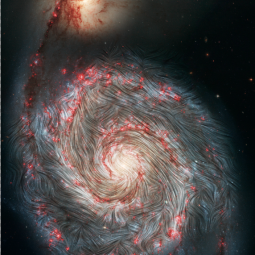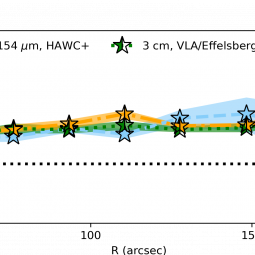By Alejandro Borlaff and Joan Schmelz
Paper:
Extragalactic Magnetism with SOFIA (Legacy Program). I. The Magnetic Field in the Multiphase Interstellar Medium of M51
Alejandro S. Borlaff
et al
2021
ApJ
921
128
Hidden deep inside their spiral structure, an invisible force is affecting the evolution of galaxies — magnetic fields. Strong enough to regulate star formation and even drive gas into a supermassive black hole, magnetic fields might be one of the most important factors influencing how spiral galaxies evolve. In theory, the field could be affecting the global kinematics of the gas, modifying the rotation curve, and the redistribution of dense clouds of gas as they condense into stars. As a consequence, the magnetic fields might indirectly be forcing stars to migrate radially in the galactic disk. To detect these effects, it is necessary to map the shape of the magnetic fields in the cold, dense molecular clouds. However, traditional observations of magnetic fields made with radio telescopes are only sensitive to the diffuse interstellar gas that surrounds these star-forming regions, far away from where these fundamental effects might be taking place.
Thanks to SOFIA, scientists have finally been able to observe the morphology of the magnetic field inside the molecular gas of the grand design Whirlpool galaxy (also known as Messier 51). The High-resolution Airborne Wideband Camera (HAWC+) is able to map the magnetic fields deep in the cold, dark molecular clouds. The research team then compared these results with the magnetic field maps of the diffuse gas made with the Very Large Array in New Mexico and the Effelsberg radio telescope in Germany.
The magnetic field lines in the inner region of the Whirlpool galaxy show a regular spiral structure, but field lines in the molecular clouds decouple from those of the diffuse gas in the outskirts — closer to the companion galaxy Messier 51b. The field structure obtained with the far-infrared observations shows a strong distortion and large differences in their orientation with respect to the structure obtained with the radio observations. This decoupling might be related to the gravitational interaction with Messier 51b, but strikingly, this effect is not found in the inter-arm region where the gas density is much lower and many fewer stars are forming.
Earlier models of the global structure and evolution of spiral galaxies that ignored the effects of magnetic fields were based on the hypothesis that the diffuse and molecular gas shared a common magnetic structure. The most important result from this work is the proof that there is a new force contribution to be reckoned with — the kpc-scale magnetic field of the molecular clouds.
The shape of spiral galaxies results from the pattern of bright H II surrounding newborn stars. The magnetic field lines are also spiral shaped, but intriguingly, astronomers are not yet sure how either of these structures — the morphological or the magnetic — are formed or how they are connected. The morphological spiral arms are possibly the result of density waves that move around the disk, compressing the gas, and creating new stars as they pass. At the same time, these density waves might also compress the magnetic field lines, aligning the turbulent fields that form inside the molecular clouds.
The observed differences between both tracers of the magnetic field support the presence of small-scale magnetic dynamos. When combined with galactic rotation and shear forces, these dynamos would help to create the striking spiral patterns visible in the magnetic field structure of the Whirlpool galaxy. Moreover, the observed differences between the orientation of the pitch angle in the inter-arm and arm regions also support the presence of spiral density waves, which would be compressing the magnetic field lines as the morphological spiral arms move through the galaxy.
The results from the SOFIA observations of the Whirlpool galaxy show that magnetic field lines are more turbulent in the densest regions of the gaseous galactic disk. Star formation processes, like supernovae or stellar winds, increase the gas turbulence in actively star-forming regions, distorting the magnetic field lines. This result was previously observed in our own galaxy, the Milky Way, but it is extremely difficult to detect in other galaxies due to their huge distances. Interestingly, the radio polarization observations suggest that it is in those turbulent regions where higher magnetic field strengths are found. This result, combined with the detected decoupling between the magnetic field structure of the diffuse and dense phases of the gas in the spiral arms, and the observed differences inside and outside the spiral arms, suggest that there is a tight connection between the gravitational interaction, star formation, spiral density waves, and the nature of galactic magnetic fields.

